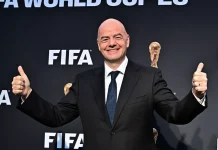The issue of the FIFA Club World Cup 2025 has provoked heated debate across the international football system in the process. Keep it at 32 teams but expand that pool of teams to the top leagues from 8 to 10, held throughout the United States and it has been positioned by FIFA as a revolutionary move in spinning club football to being leveled at the global platform.
Nevertheless, the competition has revived underlying disagreements on time, physical and mental fitness, and commercial interests that underlie elite sports. As the world is presented with a broader tournament that has the top clubs, players unions and national leagues opposing it, the biggest event is on the edge of glamour as well as tensions, it has put the game stakeholders in a point of questioning; whether the current path being taken by the game of football will lead to any success soon.
The New Format: Prestige or Pressure?
From Exclusive to Exhaustive
The shift from a seven-team format to a 32-team mega-tournament dramatically alters the Club World Cup’s scope. Over 60 matches were played in intense summer conditions, often under midday heat, involving 72 nationalities and watched by millions. FIFA positioned the tournament as the capstone of the 2024–25 club season, distributing over $1 billion in prize money, with individual club winnings reaching as high as $125 million.
Yet for all the numbers, the expansion severely compressed the calendar. The Club World Cup began just 13 days after the UEFA Champions League final and mere weeks following South America’s domestic closures. Players already fatigued from ten-month campaigns were thrust into new obligations, effectively removing any off-season and delaying pre-season recovery or tactical resets.
Players Facing a Breaking Point
In June 2025, as exemplified by Manchester City with Rodri and Barcelona with Pedri, players of the highest calibre had played more than 75 matches in the seasons, both domestically and in the European and global competitions. Numerous of them spent over 7000 minutes playing on the pitch-this is an amount way above the medical guidelines of sustainable athletic workloads. Dramatic headlines and highlight reels were made during the tournament, but it became more and more apparent that there was a cost to player welfare that was being hidden by the spectacle.
Physicians, members of FIFPRO threatened that the reduced recovery periods are very risky, especially in relation to soft-tissue and long-term neurological stresses. Cases of chronic fatigue and emotional burnout have increased especially among those players who do not have a break between the back to back contests.
Legal Resistance and Institutional Opposition
Court Challenges and Collective Action
Player unions and football associations moved swiftly. FIFPRO, the World Leagues Forum, and several European federations filed joint complaints before the Brussels Court of Commerce, contesting the legality of FIFA’s unilateral calendar expansion. These cases are now expected to escalate to the European Court of Justice, with implications not only for this tournament but for FIFA’s broader governance model.
David Terrier, President of FIFPRO Europe, described the 32-team expansion as
“the line that should not have been crossed,” adding, “Players are not machines. There’s a point where competitive ambition must yield to human limitations.”
The case hinges not just on overwork, but on whether FIFA has overridden the rights of players and leagues without appropriate consent or consultation.
Visible Resistance on the Field
MLS players, among others, publicly protested during warm-ups by wearing shirts labeled:
“Club World Cup Cash Grab.”
Despite the high-value prize pool, compensation to players remains minimal due to existing collective bargaining caps. Clubs receive upwards of $9.55 million just for participation, yet some players report bonuses of only $50,000—a clear imbalance that underscores broader frustrations.
In Spain, La Liga President Javier Tebas characterized the tournament as “an externally imposed distortion of the competitive rhythm,” criticizing FIFA for creating “short-term profit mechanisms” while weakening the long-term structure of the club game.
FIFA’s Position and the Strain of Growth
Official Justifications and Public Messaging
FIFA has remained adamant that the tournament was scheduled with player welfare in mind. President Gianni Infantino described the event as using “only 1% of the football calendar” and insisted it had been coordinated with domestic leagues and confederations. His depiction of the expansion was inclusive and gave chances to the clubs not in the traditional European and South-American upper echelons.
But the critics say there is a mismatch of such observations on the ground. The actual toll on players is greatly increased by the training camps, the need to meet with media, trans continental travel and conditions placed on players due to climate. As much as rest periods might be there on paper, in reality, it is usually superseded by the other obligations or logistical requirements.
Structural Questions and Scheduling Fallout
The Club World Cup occupies a special place in the football calendar, not in an isolated existence. It becomes a contention with the 2026 FIFA Men World cup preparation, currently taking place continentally, and the re-opening of domestic leagues in late July. To participants of soccer leagues in countries such as Brazil, Argentina, and the US, the tournament has interfered with national soccer leagues that were forced to postpone or shorten the season, which further deepened the negative spill-over impact of the event at the smaller club and national league integrity.
The Human Impact Behind the Numbers
Physical and Mental Health Costs
Experts in sports medicine have drawn attention to the systemic fatigue now embedded into elite football careers. Repeated strain injuries, declining sleep patterns, and rising mental health concerns are no longer isolated to older players. Instead, 2025 has seen top talents under 25—such as Real Madrid’s Eduardo Camavinga and Manchester United’s Alejandro Garnacho—missing key matches due to “stress-related fatigue,” a term once rare in medical assessments but now alarmingly frequent.
Scheduling changes also intensified health threats during the tournament itself. Several games were played in triple-digit Fahrenheit conditions, contributing to a record number of hydration breaks and substitutions for heat-related distress. Analysts noted a measurable drop in match tempo and quality during midday fixtures, further fueling doubts about the wisdom of the scheduling choices.
A Growing Labor Movement in Football
What once seemed unthinkable—a labor-led opposition movement in global football—is now a clear trend. Associations of players have become more audacious, more than ever before, more organized and more ready to go to court or organize symbolic protests. As the clubs and institutional bodies enter into negotiation of media rights and stadium negotiation, the voice of an athlete is gaining predominance to shape the future of the sport.
Public Sentiment and Media Scrutiny
This is the same person who has opined on the above issues during an interview on Sky Sports News having mentioned that the 2025 Club World Cup is a referendum on whether international governing bodies are prepared to put the welfare of players at risk by surrendering to the expansion of the football calendar. Their analysis put that event in the wider frame of sports decision-making where they cautioned that the maintenance of performance as well as the passion in football is now necessitating a paradigm shift in the order of priorities.
The ‘Club World Cup’, PSR loopholes and a club that isn’t (and has never been) part of a multi-club ownership model being punished for being part of a multi-club ownership model… 🤦♂️
The game has never been more gone. 👎 #CPFC pic.twitter.com/O0OjhDvNq5
— Matt Watts (@MattWatts96) July 11, 2025
Major broadcasters, while benefiting from the tournament’s media value, have not ignored these realities. Coverage has featured interviews with physiologists, psychologists, and former players—all raising the same question: where is the limit?
Commercial Success vs. Cultural Sustainability
FIFA’s success in filling large stadiums and generating global viewership is not in dispute. The Club World Cup 2025 has been a commercial success based on sponsorships, televising, and brand distribution. However, the quality and competitiveness of games have been broadly inconsistent and loss of some stars due to injuries or fatigue has hurt fan participation in major markets.
The tournament needs a legacy of a different nature, has nothing to do with cups or spectators, as it is whether it will induce a long-needed readjustment. When commercial growth outruns all other considerations, the sport will easily lose its talent, career years, and legal complications that will permanently change their structure more than any type of format.
Football’s global status is not invincible. The very players who define the game’s appeal are now openly questioning the cost of their labor and the authenticity of leadership’s stated values. Whether the Club World Cup becomes a milestone or a misstep depends on how institutions respond—not with slogans, but with systemic change.
If football refuses to confront its own limits, it may discover that the world’s most watched game is also its most fragile.













